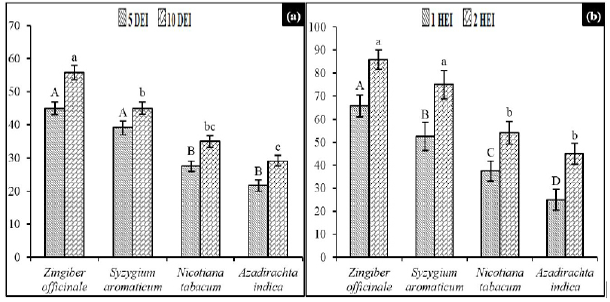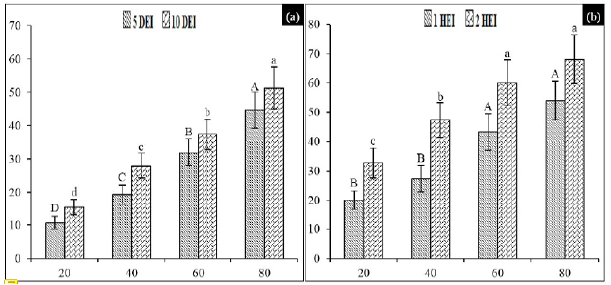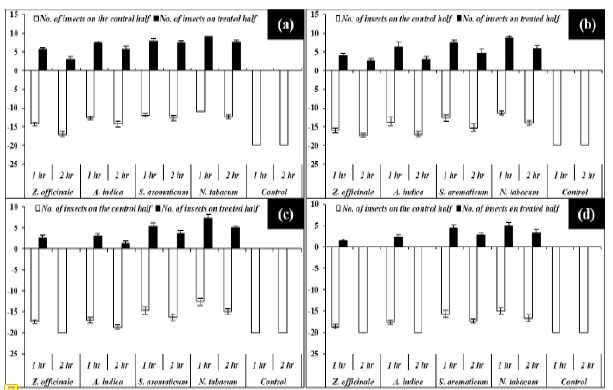Toxic and Repellent Characteristics of Some Plant Extracts used against Tribolium castaneum (Herbst) (Coleoptera: Tenebrionidae) Improve the Grain Quality of Stored Wheat
Toxic and Repellent Characteristics of Some Plant Extracts used against Tribolium castaneum (Herbst) (Coleoptera: Tenebrionidae) Improve the Grain Quality of Stored Wheat
Bilal Atta1*, Muhammad Rizwan1, Arshed Makhdoom Sabir1, Muhammad Dildar Gogi2, Muhammad Sabar1, Bakhtawar3, Faizan Ali3 and Mehran Sarwar3
Mortality (%)(a) and Repellency (%)(b) (Mean ± SE, n = 3) of Tribolium castaneum exposed to various plant extracts (Zingiber officinale, Syzygium aromaticum, Nicotiana tabacum and Azadirachta indica) at different exposure intervals. Plant extracts are on x-axis and measured variables are on y-axis. DEI = Days exposure interval; HEI = Hours exposure interval; Means with different letters are significantly different (P < 0.05), Bonferroni test, comparisons across all treatments.
Mortality (%)(a) and Repellency (%)(b) (Mean ± SE, n = 3) of Tribolium castaneum exposed to various doses (20mg, 40mg, 60mg and 80mg) of plant extracts (Zingiber officinale, Syzygium aromaticum, Nicotiana tabacum and Azadirachta indica) at different exposure intervals. Extract doses are on x-axis and measured variables are on y-axis. DEI = Days exposure interval; HEI = Hours exposure interval; Means with different letters are significantly different (P < 0.05), Bonferroni test, comparisons across all treatments.
Repellent behavior of total number of Tribolium castaneum on treated half of filter paper exposed to various plant extracts and their doses [(a) 20 ml, (b) 40 ml, (c) 60 ml, (d) 80 ml] and control half of filter paper at different exposure intervals.
Grain damage (%)(a), Grain weight loss (%)(b) and Feeding Deterrence Index (%)(c) (Mean ± SE, n = 3) due to Tribolium castaneum exposed to various crude plant extracts (Zingiber officinale, Syzygium aromaticum, Nicotiana tabacum and Azadirachta indica) at different exposure intervals. Plant extracts are on x-axis and measured variables are on y-axis. DEI = Days exposure interval; Means with different letters are significantly different (P < 0.05), Bonferroni test, comparisons across all treatments.
Grain damage (%)(a), Grain weight loss (%)(b) and Feeding Deterrence Index (%)(c) (Mean ± SE, n = 3) due to Tribolium castaneum exposed to various doses (20mg, 40mg, 60mg and 80mg) of plant extracts (Zingiber officinale, Syzygium aromaticum, Nicotiana tabacum and Azadirachta indica) at different exposure intervals. Extract doses are on x-axis and measured variables are on y-axis. DEI = Days exposure interval; Means with different letters are significantly different (P < 0.05), Bonferroni test, comparisons across all treatments.














